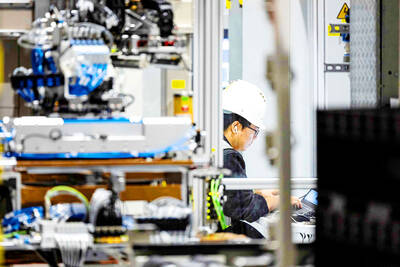VIA Technologies Inc (
"VIA's shipments in 2003 will decline because SiS is aggressively trying to take some of VIA's market share," Eric Chen (
VIA is expected to report sales of nearly 35 million chipsets for the year just ended, but Chen said the company will struggle to break the 27 million mark this year.
Supplying around 21 percent of the global chipset market, VIA is currently the world's second-largest designer of the chips that allow computer components -- such as memory and graphics -- to communicate with the main processor.
SiS follows closely, taking 19 percent of the global chipset market. This year SiS aims to take VIA's No.2 spot, Chen said. US-based Intel Corp leads the world with a 60 percent market share.
VIA's ability to stave off an attack from SiS will be hampered by the fact that it has not been granted the license to make the chipsets for Intel's latest Pentium4 processor.
SiS on the other hand has been granted the license. SiS also has its own chipmaking plant, giving it more room to cut prices, unlike VIA which outsources its chip manufacturing to Taiwan Semiconductor Manufacturing Co (TSMC,
"VIA's problem is that it has been blocked by not receiving the Pentium4 license," Chen said. "SiS is very aggressive in pricing, whereas VIA's room for cutting prices is very limited."
Uninspiring product plans for this year may cause VIA to fall even further behind.
"VIA has no killer products in its road map for 2003," Chen said.
Its rivals do. "Intel has a very competitive product road map for 2003," said Sharon Su (
Su cited a recently announced alliance between SiS and Taiwan's No.2 maker of made-to-order chips, United Microelectronics Corp (UMC,
SiS and UMC recently ended a patent dispute that had dragged on for more than two years. The first result of the settlement is that SiS can now begin to order chips from UMC again, increasing the company's production capacity. Details of the alliance are to be announced today at a special board meeting in Hsinchu.
VIA's close ally, US-based Advanced Micro Devices (AMD) is not faring well either, and will continue to lose market share to Intel, Su said.
Chen estimates that less than 5 percent of the chipsets sold globally are supplied by AMD. Around 40 percent of the chipsets VIA sells are for AMD processors.
UBS Warburg downgraded its forecast for VIA, as did Nomura.
Su slashed her forecast for VIA's sales performance for this year by 10 percent yesterday, from 32 million units down to 28.7 million. She also forecast the company's share price would drop to NT$30. VIA's shares ended 3.3 percent up yesterday at NT$40.7.
SiS ended the day up 6.7 percent at NT$31.6.

CHIP RACE: Three years of overbroad export controls drove foreign competitors to pursue their own AI chips, and ‘cost US taxpayers billions of dollars,’ Nvidia said China has figured out the US strategy for allowing it to buy Nvidia Corp’s H200s and is rejecting the artificial intelligence (AI) chip in favor of domestically developed semiconductors, White House AI adviser David Sacks said, citing news reports. US President Donald Trump on Monday said that he would allow shipments of Nvidia’s H200 chips to China, part of an administration effort backed by Sacks to challenge Chinese tech champions such as Huawei Technologies Co (華為) by bringing US competition to their home market. On Friday, Sacks signaled that he was uncertain about whether that approach would work. “They’re rejecting our chips,” Sacks

It is challenging to build infrastructure in much of Europe. Constrained budgets and polarized politics tend to undermine long-term projects, forcing officials to react to emergencies rather than plan for the future. Not in Austria. Today, the country is to officially open its Koralmbahn tunnel, the 5.9 billion euro (US$6.9 billion) centerpiece of a groundbreaking new railway that will eventually run from Poland’s Baltic coast to the Adriatic Sea, transforming travel within Austria and positioning the Alpine nation at the forefront of logistics in Europe. “It is Austria’s biggest socio-economic experiment in over a century,” said Eric Kirschner, an economist at Graz-based Joanneum

BUBBLE? Only a handful of companies are seeing rapid revenue growth and higher valuations, and it is not enough to call the AI trend a transformation, an analyst said Artificial intelligence (AI) is entering a more challenging phase next year as companies move beyond experimentation and begin demanding clear financial returns from a technology that has delivered big gains to only a small group of early adopters, PricewaterhouseCoopers (PwC) Taiwan said yesterday. Most organizations have been able to justify AI investments through cost recovery or modest efficiency gains, but few have achieved meaningful revenue growth or long-term competitive advantage, the consultancy said in its 2026 AI Business Predictions report. This growing performance gap is forcing executives to reconsider how AI is deployed across their organizations, it said. “Many companies

France is developing domestic production of electric vehicle (EV) batteries with an eye on industrial independence, but Asian experts are proving key in launching operations. In the Verkor factory outside the northern city of Dunkirk, which was inaugurated on Thursday, foreign specialists, notably from South Korea and Malaysia, are training the local staff. Verkor is the third battery gigafactory to open in northern France in a region that has become known as “Battery Valley.” At the Automotive Energy Supply Corp (AESC) factory near the city of Douai, where production has been under way for several months, Chinese engineers and technicians supervise French recruits. “They